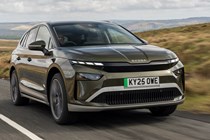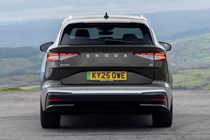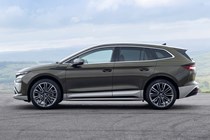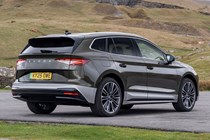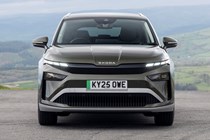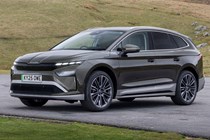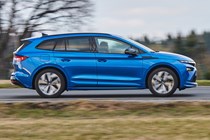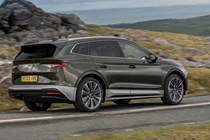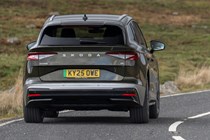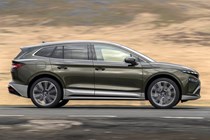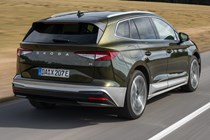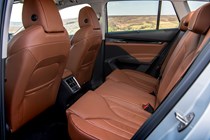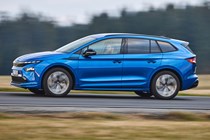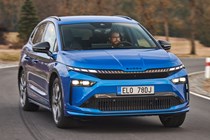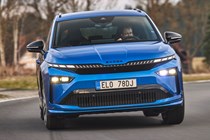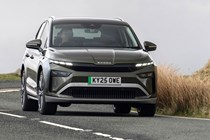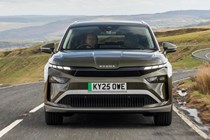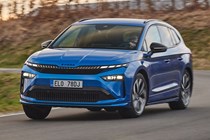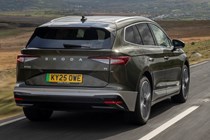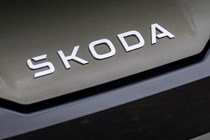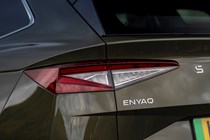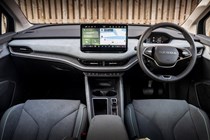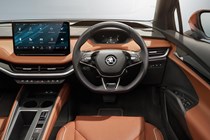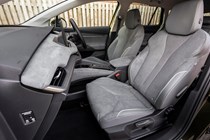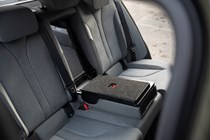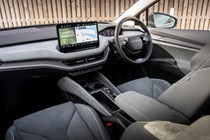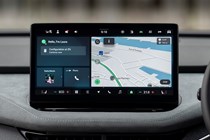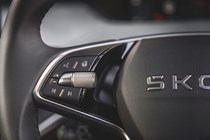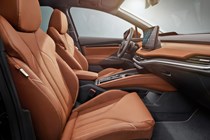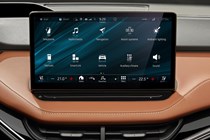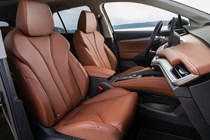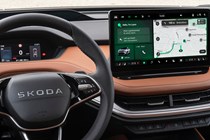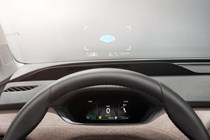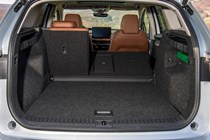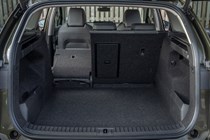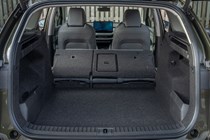
Skoda Enyaq boot space, practicality and safety
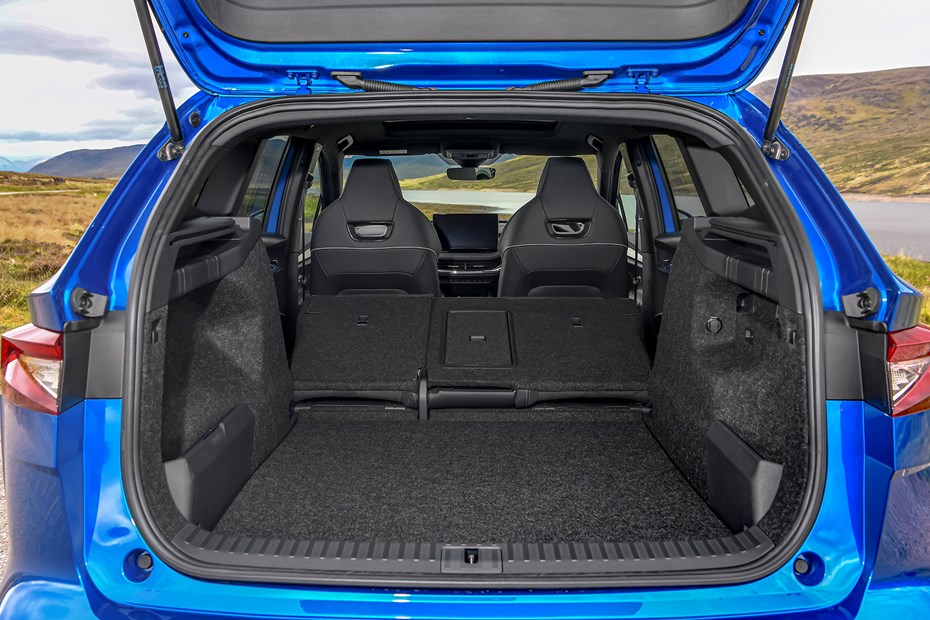
- Lots of room for passengers
- Large boot
- Flat floor, lots of storage spaces inside the cabin
How much space is there?
Aside from the techfest dashboard, the Skoda Enyaq iV is quite conventional inside. It’s good looking, well-trimmed from a tasteful range of materials and well-screwed together from high-quality components. The front seats are inviting and comfortable, and it’s easy to get yourself well adjusted regardless of your size.
The rear seats have more space than average for the class and a similar amount to the Kodiaq SUV, although while that is available with seven seats, the Enyaq is not. There’s ample footroom, making this an easy five-seater, aided by the flat floor with minimal intrusion, although taller testers would have liked a little more kneeroom. A Renault Scenic is better here.
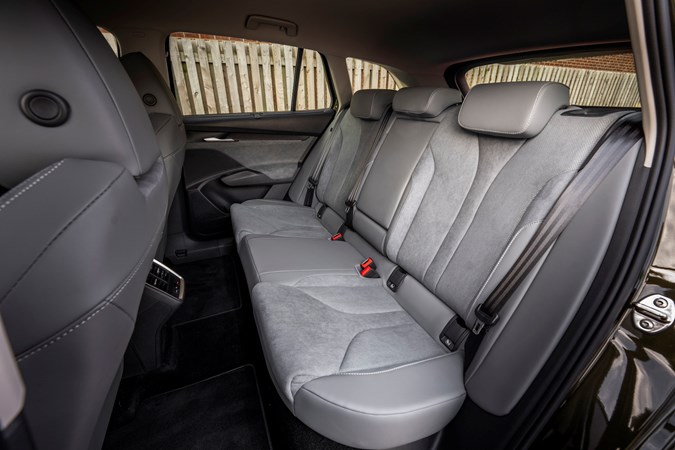
Boot space and storage
Just like pretty much every other Skoda, it’s also very practical. The boot has a capacity of 585 litres with the rear bench in place and 1,710 with it folded. That compares with 640 and 1,700 litres for famously capacious Skoda Octavia Estate, and is larger than most of its direct rivals. Sadly, the Enyaq’s seats don’t fold completely flat leaving a bit of a ramp to push long items up.
Unlike many electric car rivals, there’s no additional load capacity under the bonnet for cables which is a bit of a shame. It’s also worth pointing out the boot has a high loading lip, which might pose a problem when putting in heavy items, or getting your dog in the back. A two-level boot floor helps with this, though.
Is it easy to park?
The Skoda Enyaq is a bulky car that’s not blessed with the greatest of visibility. It’s difficult to know where the corners are, and could make it tough to park were it not for the fact that all models do come with parking sensors and a rear-camera. A surround-view camera is available and standard on Sportline.
Safety
- Five-star safety rating from Euro NCAP
- Adaptive cruise control with lane assist available
- Comes with nine airbags
The Skoda Enyaq iV is packed with all of the latest safety equipment you’d expect. So, it comes with up to nine airbags, including a central airbag between the front seats, and comprehensive Proactive Occupant Protection.
Numerous state-of-the-art assistance systems alert the driver to potential collisions in many situations and even actively help to prevent them or minimise the consequences. These include Front Assist with predictive pedestrian and cyclist protection, Side Assist including Rear Traffic Alert, as well as Collision Avoidance Assist, Turn Assist and Exit Warning.
The assist systems work well, and didn’t at any point falsely alert us to an impending collision, not something that could be said of our long-term Kodiaq. Lane assist wasn’t too violent or OTT in its operation and is easy to turn off anyway.
The Adaptive Cruise Control (ACC) system can take some of the strain on the motorway and also includes Adaptive Lane Assist with roadworks recognition. Expect to have to make the odd correction to the steering whilst in use. Also, full LED matrix headlights are available as options for the Enyaq.
Watch the Skoda Enyaq iV safety test video
Euro NCAP rating
| What is Euro NCAP? ⓘ | |
|---|---|
| Adult Occupant: | 94% |
| Child Occupant: | 89% |
| Vulnerable Road User: | 71% |
| Safety Assist: | 82% |
Equipment and options
- 3x3 point rear seat belts
- ABS
- Alarm
- Driver`s airbag
- Electric mirrors
- Front electric windows
- Heated mirrors
- Isofix child seat anchor points
- Passenger`s airbag
- Rear electric windows
- Sat Nav
- Side airbags
- Steering wheel rake adjustment
- Steering wheel reach adjustment
- Traction control
- Body coloured bumpers
- Central locking
- Folding rear seats
- Height adjustable drivers seat
- PAS
- Roof rails
- Cruise control
- Electric driver`s seat
- Electric passenger`s seat
- Front fog lights
- Headlight washers
- Heated seats
- Leather seat trim
- Lumbar support
- Parking sensors
- Partial leather seat trim
- Body coloured bumpers
- Folding rear seats
- Height adjustable drivers seat
- Leather seat trim
- Lumbar support
- Parking sensors
- PAS
- Remote locking
- Roof rails
- Cruise control
- Heated seats
- Body coloured bumpers
- Cloth seat trim
- Cruise control
- Folding rear seats
- Height adjustable drivers seat
- Lumbar support
- Parking sensors
- PAS
- Remote locking
- Roof rails
- n/a
- Body coloured bumpers
- Folding rear seats
- Height adjustable drivers seat
- Lumbar support
- Parking sensors
- Partial leather seat trim
- PAS
- Remote locking
- Roof rails
- Cloth seat trim
- Cruise control
- Heated seats
- Leather seat trim
- Body coloured bumpers
- Folding rear seats
- Height adjustable drivers seat
- Lumbar support
- Parking sensors
- Partial leather seat trim
- PAS
- Remote locking
- Roof rails
- Cruise control
- Heated seats
- Body coloured bumpers
- Folding rear seats
- Height adjustable drivers seat
- Leather seat trim
- Lumbar support
- Parking sensors
- PAS
- Remote locking
- Roof rails
- Cruise control
- Heated seats
- Body coloured bumpers
- Folding rear seats
- Leather seat trim
- Lumbar support
- PAS
- Remote locking
- Roof rails
- Cruise control
- Electric driver`s seat
- Headlight washers
- Heated seats
- Height adjustable drivers seat
- Parking sensors
- Body coloured bumpers
- Cruise control
- Folding rear seats
- Headlight washers
- Height adjustable drivers seat
- Leather seat trim
- Lumbar support
- Metallic Paint
- Parking sensors
- PAS
- Remote locking
- Roof rails
- n/a
- Body coloured bumpers
- Cloth seat trim
- Cruise control
- Folding rear seats
- Height adjustable drivers seat
- Lumbar support
- Parking sensors
- PAS
- Remote locking
- Roof rails
- n/a
- Body coloured bumpers
- Folding rear seats
- Lumbar support
- Partial leather seat trim
- PAS
- Remote locking
- Roof rails
- Cruise control
- Electric driver`s seat
- Headlight washers
- Heated seats
- Height adjustable drivers seat
- Parking sensors
- Body coloured bumpers
- Folding rear seats
- Lumbar support
- Partial leather seat trim
- PAS
- Remote locking
- Roof rails
- Cruise control
- Electric driver`s seat
- Headlight washers
- Heated seats
- Height adjustable drivers seat
- Parking sensors
- Cruise control
- Folding rear seats
- Headlight washers
- Heated seats
- Height adjustable drivers seat
- Leather seat trim
- Lumbar support
- Parking sensors
- PAS
- Remote locking
- Roof rails
- Partial leather seat trim
- Body coloured bumpers
- Electric driver`s seat
- Folding rear seats
- Front fog lights
- Headlight washers
- Heated seats
- Lumbar support
- Partial leather seat trim
- PAS
- Remote locking
- Roof rails
- Electric passenger`s seat
- Height adjustable drivers seat
- Parking sensors
- Body coloured bumpers
- Folding rear seats
- Leather seat trim
- Lumbar support
- PAS
- Remote locking
- Roof rails
- Cruise control
- Electric driver`s seat
- Headlight washers
- Heated seats
- Height adjustable drivers seat
- Parking sensors
- Folding rear seats
- Headlight washers
- Heated seats
- Lumbar support
- Partial leather seat trim
- PAS
- Remote locking
- Roof rails
- Body coloured bumpers
- Cruise control
- Electric driver`s seat
- Front fog lights
- Height adjustable drivers seat
- Leather seat trim
- Parking sensors
- Body coloured bumpers
- Electric driver`s seat
- Front fog lights
- Headlight washers
- Heated seats
- Lumbar support
- Partial leather seat trim
- PAS
- Remote locking
- Roof rails
- Electric passenger`s seat
- Folding rear seats
- Height adjustable drivers seat
- Leather seat trim
- Metallic Paint
- Parking sensors
- Central locking
- Electric driver`s seat
- Folding rear seats
- Front fog lights
- Heated seats
- PAS
- Body coloured bumpers
- Electric passenger`s seat
- Headlight washers
- Height adjustable drivers seat
- Leather seat trim
- Lumbar support
- Parking sensors
- Partial leather seat trim
- Roof rails
- Body coloured bumpers
- Central locking
- Cruise control
- Folding rear seats
- Height adjustable drivers seat
- Lumbar support
- Partial leather seat trim
- PAS
- Roof rails
- n/a
- Central locking
- Folding rear seats
- Heated seats
- Height adjustable drivers seat
- Lumbar support
- PAS
- Roof rails
- n/a
- Central locking
- Electric driver`s seat
- Folding rear seats
- Front fog lights
- Heated seats
- Height adjustable drivers seat
- Roof rails
- Electric passenger`s seat
- Parking sensors
- PAS
- Body coloured bumpers
- Central locking
- Electric driver`s seat
- Folding rear seats
- Front fog lights
- Headlight washers
- Heated seats
- Height adjustable drivers seat
- Partial leather seat trim
- PAS
- Roof rails
- Electric passenger`s seat
- Lumbar support
- Parking sensors
- Electric driver`s seat
- Front fog lights
- Heated seats
- Height adjustable drivers seat
- Leather seat trim
- Metallic Paint
- Partial leather seat trim
- Roof rails
- Body coloured bumpers
- Central locking
- Electric passenger`s seat
- Folding rear seats
- Headlight washers
- Lumbar support
- Parking sensors
- PAS
- Remote locking
Dimensions
| Length | 4649mm - 4660mm |
|---|---|
| Width | 1879mm - 2148mm |


